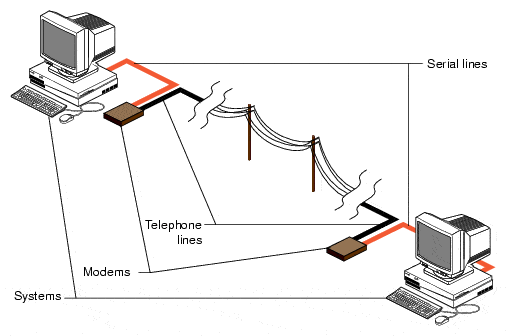The Serial Line Internet Protocol (SLIP) is an early network protocol designed for connecting devices over serial lines. Initially used for Internet connectivity via dial-up modems, SLIP was fundamental in the early days of the Internet.
This article will delve into SLIP’s origins, its basic operation, and its limitations. We’ll also explore CSLIP (Compressed SLIP), a variant designed to optimize data transmission. Furthermore, we discuss the transition from SLIP to its successor, the Point-to-Point Protocol (PPP), highlighting the reasons behind this technological shift.
Table of Contents:
- What is SLIP Protocol?
- Historical Overview of SLIP Protocol
- Technical Aspects of SLIP
- CSLIP: Understanding Compressed SLIP
- SLIP vs. PPP: The Transition
- SLIP’s Legacy and Modern Relevance
- References

1. What is SLIP Protocol?
The Serial Line Internet Protocol (SLIP) is an industry-standard protocol developed in 1984 for UNIX environments that supports TCP/IP networking over serial transmission lines. These serial lines are typically dial-up connections using a modem. his protocol allows TCP/IP hosts to access the Internet via dial-up through SLIP servers located at ISPs. SLIP’s significance lies in its early role in internet connectivity, enabling devices to communicate over telephone lines, a foundational step in the development of network communication technologies.
2. Historical Overview of SLIP Protocol
SLIP’s inception in 1984 marks a pivotal moment in the history of internet protocols. Initially developed for UNIX systems, it emerged as a straightforward solution for connecting computers to the internet via serial lines—then a predominant method of internet access. This protocol played a crucial role in the early days of online connectivity, particularly before the advent of broadband and wireless technologies. Its simplicity and ease of implementation made it a popular choice among early internet users and providers, setting the stage for more advanced protocols that followed. SLIP’s legacy is underscored by its contribution to the evolution of internet accessibility, serving as a stepping stone towards more sophisticated and efficient networking protocols.
3. Technical Aspects of SLIP
3.1 Basic Operation
The Serial Line Internet Protocol (SLIP) operates by encapsulating datagrams over serial lines. It uses a simple mechanism where each IP packet is placed between two special characters: an END character at the beginning and end, and an ESC character if these special characters appear in the data. This method, known as character stuffing, ensures the receiver can distinguish data packets from control information. The simplicity of SLIP, with no header or additional error-checking mechanisms, contributes to its ease of use but also to its limitations.

3.2 Configuration and Limitations
Configuring SLIP involves setting up the serial line for packet transmission, which typically includes specifying parameters like baud rate and data format. Due to its minimalistic design, SLIP lacks built-in error correction, authentication, and compression, which are essential for reliable and secure data transmission. Moreover, SLIP does not support automatic IP address assignment, requiring manual configuration. These limitations became apparent as internet use grew and led to the development of more robust protocols like PPP, which offer better error handling, authentication, and support for multiple network layer protocols.
4. CSLIP: Understanding Compressed SLIP
Compressed Serial Line Internet Protocol (CSLIP) is an enhanced version of the standard SLIP protocol, designed to optimize data transmission over serial lines like phone connections. CSLIP distinguishes itself by employing Van Jacobson compression, a technique that significantly reduces the overhead by transmitting only the differences between successive IP packets. This compression allows CSLIP to minimize the header size of packets from 24 bytes in standard SLIP to as little as 5 bytes in CSLIP. This reduction is particularly beneficial for transmitting long documents or data with many small packets, as it leads to substantial savings in the overall bytes transmitted. CSLIP, thereby, enhances the efficiency of data transmission in environments where bandwidth is limited.
For more detailed information, you can refer to RFC 1055, which discusses the SLIP protocol, and RFC 1141, which describes Van Jacobson compression.
5. SLIP vs. PPP: The Transition
The transition from the Serial Line Internet Protocol (SLIP) to the Point-to-Point Protocol (PPP) marks a significant evolution in network communication protocols. While SLIP was groundbreaking for its time, enabling TCP/IP networking over serial lines, it had notable limitations in error handling, security, and protocol support. PPP, developed as a more advanced alternative, addressed these issues. It introduced features like error correction, authentication, and support for multiple network protocols, making it more suitable for the growing demands of internet connectivity. This transition underlines the advancement in networking technology, reflecting the shift towards more robust, secure, and versatile communication protocols for internet access.
5.1 Why PPP Replaced SLIP
SLIP Protocol has been largely replaced by the Point-to-Point Protocol (PPP) for the following reasons:
- SLIP supports only TCP/IP, while PPP is a multiprotocol encapsulation protocol that can also support Internetwork Packet Exchange (IPX) and AppleTalk. This is not an issue, however, if you are connecting to the Internet, which is strictly TCP/IP-based.
- SLIP generally requires that the host’s TCP/IP parameters be configured manually, while PPP can negotiate the parameters during session establishment. These parameters include the IP address of the host, the window size, and compression.
- SLIP might require the user to write a script for automating the logon process, while PPP supports both the Password Authentication Protocol (PAP) and the Challenge Handshake Authentication Protocol (CHAP), which lets you automatically forward your credentials to the PPP server for authentication.
In sum, PPP (Point-to-Point Protocol) replaced SLIP (Serial Line Internet Protocol) primarily due to its enhanced features and capabilities. SLIP, being one of the earliest protocols for serial line internet connections, lacked several critical functionalities such as error detection and correction, compression, and support for multiple network protocols. PPP, on the other hand, was designed to overcome these limitations. It introduced robust error handling mechanisms, authentication for secure connections, and the ability to carry packets from different network protocols, making it a more versatile and reliable choice for internet connectivity.
5.2 Comparative Advantages of PPP
The advantages of PPP over SLIP are significant. Firstly, PPP includes built-in error detection and correction mechanisms, ensuring data integrity and reliable communication. Secondly, it supports a wider range of network layer protocols, not just IP, which enhances its applicability in diverse networking environments. Thirdly, PPP provides options for data compression, improving bandwidth utilization. Additionally, PPP’s support for authentication protocols like PAP and CHAP enhances security, a crucial aspect in modern networking. These features collectively make PPP a more advanced and suitable protocol for current networking requirements.
6. SLIP’s Legacy and Modern Relevance
The Serial Line Internet Protocol (SLIP), though largely replaced by more advanced protocols, leaves a lasting legacy in the realm of computer networking. Its simplicity and ease of implementation were crucial in the early stages of internet development, providing a foundational step for remote internet access. Today, while SLIP is not commonly used in modern networking, its influence is evident in the evolution of network protocols. It serves as a historical reminder of the internet’s developmental journey and the continuous pursuit of more efficient, secure, and robust communication technologies.
7. References
- “Computer Networks” by Andrew S. Tanenbaum.
- “Encyclopedia of Networking” 2nd Edition, by Werner Feibel.
- “Guide to Networking Essentials” 7th Edition, by Greg Tomsho.
- RFC 1055: “A Nonstandard for Transmission of IP Datagrams over Serial Lines: SLIP”.
- RFC 1141: “Incremental updating of the Internet checksum”.